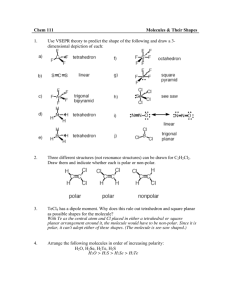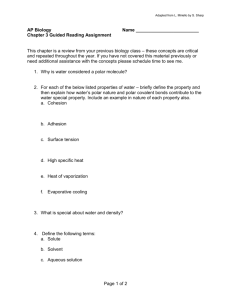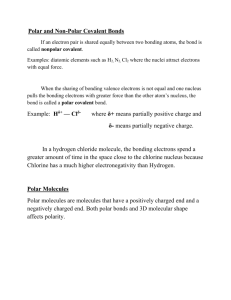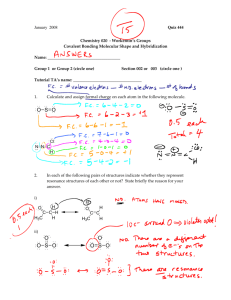Electronegativity, Polar Bonds and Molecular Polarity
advertisement
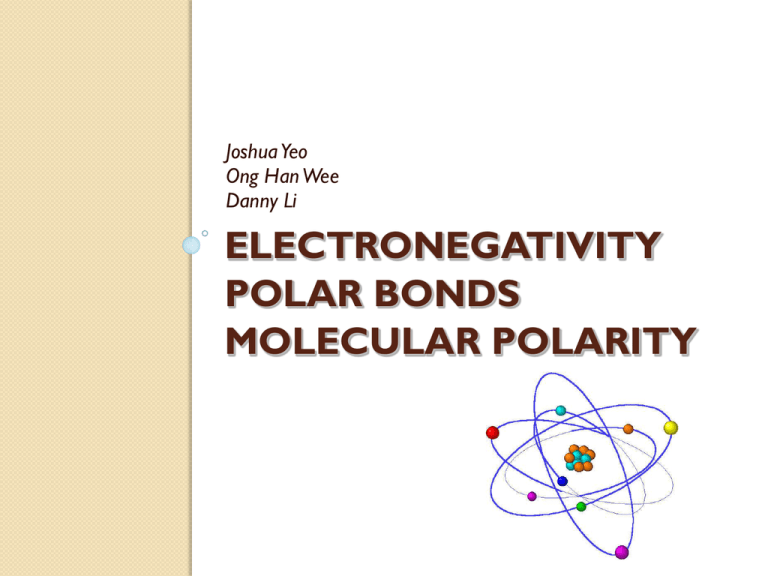
Joshua Yeo Ong Han Wee Danny Li ELECTRONEGATIVITY POLAR BONDS MOLECULAR POLARITY Some terms we will be explaining Electronegativity Polarity Hydrogen bonding Electron density Dipole moment Etc… ELECTRONEGATIVITY IN COVALENT AND IONIC BONDING Electronegativity Definition A measure of the tendency of an atom to attract electrons towards itself. e- What happens when two atoms of equal electronegativity bond together? Equally electronegative Same tendency to attract the bonding pair of electrons Electrons average half way between the two atoms A non-polar bond is formed (To get a bond like this, A and B would usually have to be the same atom.) A.K.A - a "pure" covalent bond - where the electrons are shared evenly between the two atoms. What happens if B is slightly more electronegative than A? B end of the bond has more than its fair share of electrons and so becomes slightly negative. A end, short of electrons, becomes slightly positive. In the diagram, - (read as "delta") means “slightly negative”, while + means “slightly positive”. Polar bonds This is described as a polar bond. A covalent bond in which there is a separation of charge between one end and the other ◦ One end is slightly positive and the other slightly negative. Examples: most covalent bonds. The hydrogenchlorine bond in HCl or the hydrogen-oxygen bonds in water. What happens if B is a lot more electronegative than A? Electron pair is dragged right over to B's end of the bond. A has lost control of its electron, and B has complete control over both electrons. Ions have been formed. Electronegativity Attraction that a bonding pair of electrons feels for a particular nucleus depends on: Number of protons in the nucleus Distance from the nucleus Amount of screening by inner electrons Pauling’s Scale Electronegativity cannot be directly measured and must be calculated from other atomic or molecular properties Most commonly used method of calculation is that originally proposed by Pauling Commonly referred to as the Pauling scale, on a relative scale running from 0.7 to 4.0 Electronegativity in Pauling units Pauling’s Scale Explaining the trends Number of protons in the nucleus 1. ◦ Proton number increases, charge increases Distance from the nucleus 2. ◦ Equal distance since bonding electrons are all in the same valence shell Amount of screening by inner electrons 3. ◦ Same valence shell, equal screening effect Explaining the trends Number of protons in the nucleus 1. ◦ Proton number increases, charge increases Distance from the nucleus 2. ◦ Increase since number of electron shells and quantum number increase Amount of screening by inner electrons 3. ◦ Increase since number of electrons in inner shells increase ELECTRON DENSITY Electron Density Electron density is the measure of the probability of an electron being present at a specific location. (i.e. how likely you are to find an electron at a particular place) Electron Density Heisenberg Uncertainty Principle : you can't know with certainty where an electron is and where it's going next Electron Density a 2p orbital A region of space is called an orbital is where the electron will be found 95% of the time Higher electron density (where the dots are thicker) nearer the nucleus POLARITY Dipole Moment Separation of positive and negative charges Formed when the electron density of one side of a molecule is higher than the other Due to a higher electronegativity A polar bond must be present Polar Molecules A molecule would be polar when: 1. It has dipoles 2. It does not have rotational symmetry / dipoles do not cancel one another Polar Molecules? Is this a polar molecule? 1. It has dipoles 2. It does not have rotational symmetry Is this a polar molecule? 1. It has dipoles 2. It does not have rotational symmetry Is this a polar molecule? 1. It has dipoles 2. It does not have rotational symmetry Polar Molecules? Is this a polar molecule? 1. It has dipoles 2. Dipoles do not cancel one another Is this a polar molecule? Acetic Acid 1. It has dipoles 2. Dipoles do not cancel one another Is this a polar molecule? 1. It has dipoles Acetone 2. Dipoles do not cancel one another Physical Properties Cl- Na+ ◦ Non-polar solutes are soluble in non-polar solvents (eg. Hexane) ClNa+ Na◦+ Most organic molecules are relatively non-polar ◦ Polar solutes are soluble in polar solvents (eg. Water the universal solvent) Na+ ClCl◦- Mineral salts and most sugars are highly polar Cl- Solvent Applications ◦+ To dissolve certain + materials for usage Cl Na Na ◦ Liquid-liquid separation Purification and separation of solutes Na+ Cl- Na+ Cl- Cl- Na+ Cl- Na+ Na+ Cl- Na+ Cl- Cl- Na+ Cl- Na+ Na+ Cl- Na+ Cl- Solvent Boiling point[7 Chemical formula ] Dielectric constant[8] Density Dipole mome nt Non-polar solvents Pentane CH3-CH2-CH2-CH2CH3 36 °C 1.84 0.626 g/m l 0.00 D 0.00 D Cyclopentane C5H10 40 °C 1.97 0.751 g/m l Hexane CH3-CH2-CH2-CH2CH2-CH3 69 °C 1.88 0.655 g/m l 0.00 D 2.02 0.779 g/m l 0.00 D 0.00 D Cyclohexane C6H12 81 °C Benzene C6H6 80 °C 2.3 0.879 g/m l Toluene C6H5-CH3 111 °C 2.38 0.867 g/m l 0.36 D 1,4-Dioxane /-CH2-CH2-O-CH2CH2-O-\ 101 °C 2.3 1.033 g/m l 0.45 D Chloroform CHCl3 61 °C 4.81 1.498 g/m l 1.04 D 4.3 0.713 g/m l 1.15 D Diethyl ether CH3CH2-O-CH2-CH3 35 °C Chloroform CHCl3 61 °C 4.81 Diethyl ether CH3CH2-O-CH2-CH3 35 °C 4.3 0.713 g/m l 1.15 D 9.1 1.3266 g/m l 1.60 D 1.75 D g/m l 1.04 D Polar aprotic solvents Dichloromethane (DCM) CH2Cl2 Tetrahydrofuran (THF) /-CH2-CH2-O-CH2CH2-\ 66 °C 7.5 0.886 g/m l Ethyl acetate CH3-C(=O)-O-CH2CH3 77 °C 6.02 0.894 g/m l 1.78 D 21 0.786 g/m l 2.88 D 3.82 D Acetone CH3-C(=O)-CH3 40 °C 56 °C Dimethylformamide (DMF) H-C(=O)N(CH3)2 153 °C 38 0.944 g/m l Acetonitrile (MeCN) CH3-C≡N 82 °C 37.5 0.786 g/m l 3.92 D 46.7 1.092 g/m l 3.96 D Dimethyl sulfoxide (DMSO) CH3-S(=O)-CH3 189 °C Polar protic solvents 1.21 highly g/m l These bind charged solutes Formic acid to positively H-C(=O)OH 1.41 D 101 °C well due58to the electronegative atom at one side of the solvent molecule (usually O) 0.810 Dimethyl sulfoxide (DMSO) 189 °C CH3-S(=O)-CH3 46.7 1.092 g/m l 3.96 D 58 1.21 g/m l 1.41 D 1.63 D Polar protic solvents 101 °C Formic acid H-C(=O)OH n-Butanol CH3-CH2-CH2-CH2OH 118 °C 18 0.810 g/m l Isopropanol (IPA) CH3-CH(-OH)-CH3 82 °C 18 0.785 g/m l 1.66 D 20 0.803 g/m l 1.68 D 1.69 D n-Propanol CH3-CH2-CH2-OH 97 °C Ethanol CH3-CH2-OH 79 °C 30 0.789 g/m l Methanol CH3-OH 65 °C 33 0.791 g/m l 1.70 D 1.74 D 1.85 D Acetic acid CH3-C(=O)OH 118 °C 6.2 1.049 g/m l Water H-O-H 100 °C 80 1.000 g/m l These bind to negatively charged solutes well using hydrogen bonding from the singular outward H atom(s) Physical Properties Hydrophilic VS Hydrophobic ◦ ◦ ◦ ◦ ◦ Hydrophilic likes water Hydrophobic dislike water Polar molecules are hydrophilic Non-polar molecules are hydrophobic Certain molecules have non-polar and polar ends of the molecule, displaying both non-polar and polar characteristics ◦ This would result in a hydrophobic end and a hydrophilic end Applications - Soap Soap contains a hydrophilic head and a hydrophobic hydrocarbon tail Hydrophobic tail is attracted to dirt particles or soap surfaces Hydrophilic head is attracted to water This forms a link between water and the dirt molecules When water is run through a soaped dirt layer the soap will “pull” the dirt off the surface Dirt Dirt Dirt Common Examples Polar ◦ Water ◦ Ammonia Non-polar ◦ Carbon dioxide ◦ Methane Intermolecular Bonding Van der Waal’s Force 1. Hydrogen bonds: formed between molecules which have a strongly electronegative atom and a hydrogen atom, with the hydrogen gaining a partial positive charge. 2. Permanent Dipole (PD) - PD: one atom of a molecule is distinctly more electronegative than the other. This results in one side having a permanent partial positive charge and the other side having a permanent negative charge 3. Induced Dipole (ID) - ID: random movement of the electrons in the molecule. At any point in time, the electron cloud at one part of the molecule may be more dense than another side of the atom Thank you


